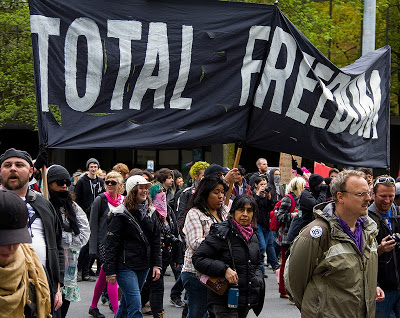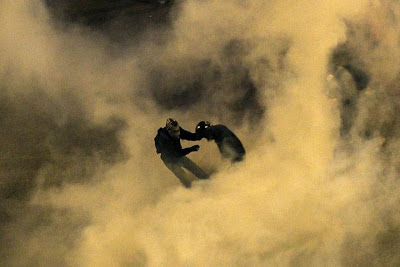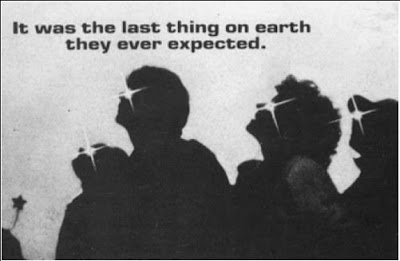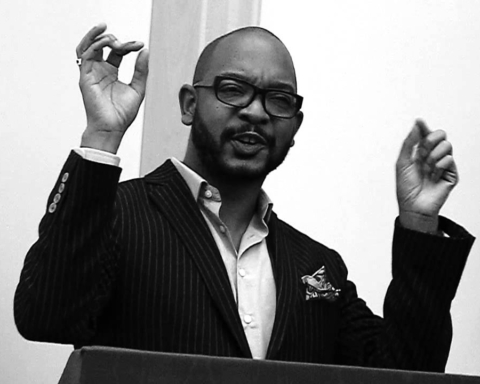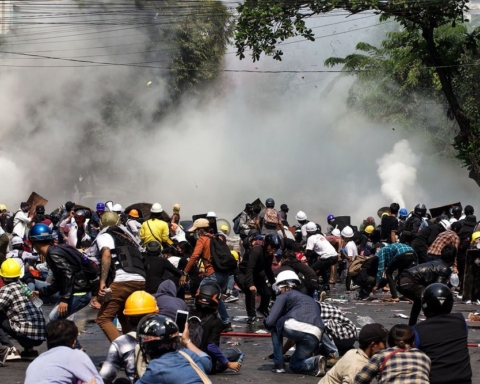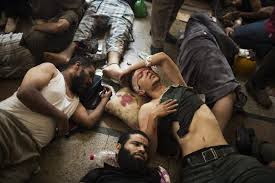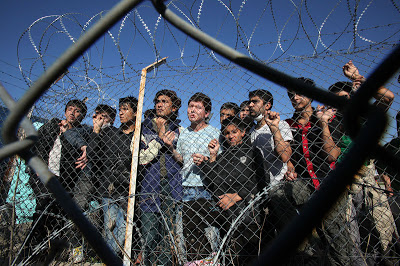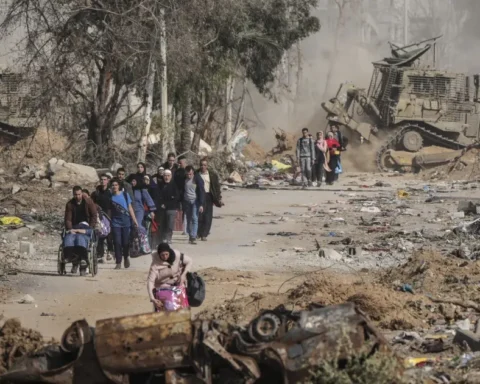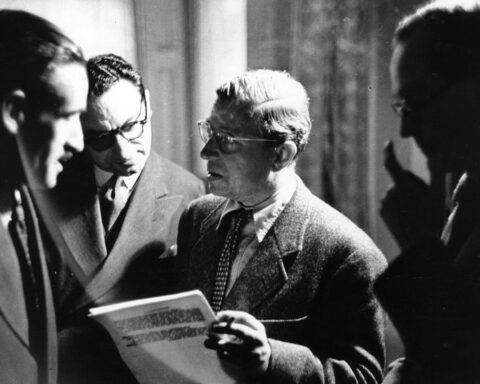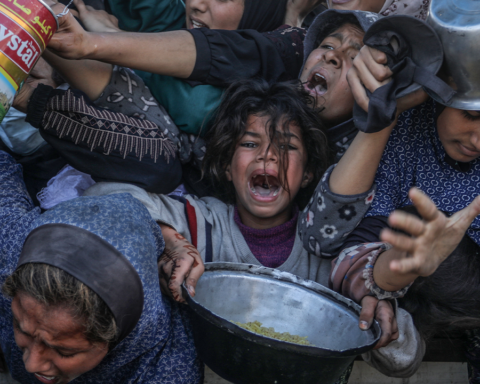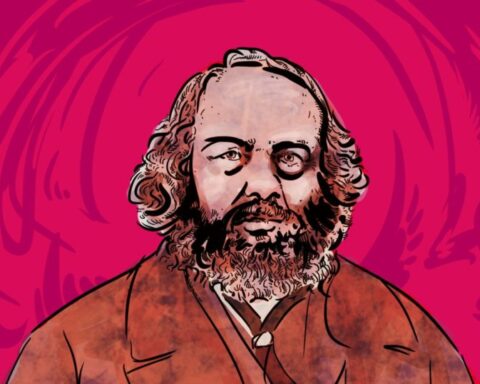Perhaps one of the greatest difficulties anarchists face on a day to day level is that of finding reliable comrades with whom to carry out ongoing projects of revolt that are integral to their lives – projects that go beyond the customary formulas that can be found everywhere (Food Not Bombs, Critical Mass, collective businesses…). These formulaic projects develop easily because they require little thought. For the same reason (no real need to think) most anarchists seem to have little problem with spontaneous one-time night activities. But it is difficult to keep any sort of ongoing project in which a combined practical and theoretical effort is necessary going. Such projects demand an continuous assessment of what we are doing and why we are doing it in terms of our revolutionary desires, our relations with comrades and other people and the reality we are facing. They keep on calling our lives into question and provide no comfortable place to rest and say “I am content, I have it all together, I have no need to struggle with myself.” I think we all fear this.
For most anarchists, anarchy and revolution remain abstractions external to them, because their own lives remain external to them. They do not see their life as a totality and so they do not consider what they want to do with it on that level. So they don’t ever feel the need to create practical projects as an outgrowth of a life of revolt involving ways of relating that reflect the world they desire. This is not simply a matter of personal failing on the part of individual anarchists. There are concrete social reasons why people usually fail to get beyond this point of thoughtless activity. The social reality in which we exist forms its own totality and imposes it on our lives. Recognizing this imposed totality in a direct way would place an ultimatum before us that few of us are ready to face, one that demands looking the horror of our present world in the face and choosing to oppose it in its totality. It is easier for us to break our lives down into separate incidents, events, spaces and moments in order to avoid facing the full significance of this imposed totality. But this totality is that of the state and the market, the intertwining rule of wealth and power. And it imposes itself precisely by breaking our lives down into separate pieces, unrelated moments, alienated fragments. So our tendency to protect ourselves in this way plays right into its hands. Separated in this way, the incidents, relationships, activities and moments of our lives have no real meaning for us as individuals. So this tendency toward fragmentation is something we need to battle in every moment.
But to fight it, we need to try to understand how it operates on a concrete level. It is the reality of our daily lives, the endless parade of meaningless interactions and activities in which we are forced to participate: working, paying rent, buying and selling, paying bills, dealing with the presence of cops, bureaucrats, bosses, landlords, etc., etc. All of this together makes us dependent on the totality of the social order and at the same time transforms us into atoms that mainly seem to bump into each other randomly due to circumstances beyond our control in the meaningless, ceaseless movement of commerce. In the United States, an ideology has grown around this that absurdly goes by the name of “rugged individualism”. The absurdity is dual. First of all this ideology defines “individuality” precisely in terms of this atomized existence in which each one is nothing more than a cipher, equal to and separate from every one else in their nothingness. Secondly, these atomized beings that are the “individuals” of this ideology are made absolutely dependent by a social order that defines their lives as a competition for the same petty ends, thus guaranteeing their ongoing identity and separation. There is certainly nothing rugged in such abject dependence. The aspect of social fragmentation that this ideology seeks to justify – atomization –may play a major part in our inability to create real projects of affinity together that spring from our own lives, particularly if its ideological justification has penetrated into our own ways of conceiving individuality.
It seems to me that we still often perceive things in a fragmented and atomized manner. We look at work, the payment of rent, buying and selling, etc. as separate problems and come up with solutions such as work avoidance, squatting, shoplifting and dumpster diving, etc. (all fine things to do, mind you, but only in a context of the total conscious creation of our lives in revolt against this world). Since we perceive the problem in a fragmented manner, we look upon fragmented, often solitary, activities as solutions, and our practice remains one of getting by within this society. So there needs to be something deeper behind our projects, something that recognizes the totality of the enemy we face and the totality of what we desire on a concrete level. This begins with grasping our lives as a totality of our own. But what does this mean?
From Stirner, we get the clue that each of us must be our own basis, and from Vaneigem we get the further clue that this requires a “reversal of perspective”, in other words, turning around to look at the world from a new perspective – our own. But these clues remain useless if we continue to conceive of individuality in the way this society does, as something abstract and isolated, as some mystical “nature” within each of us, completely separated from the relationships that make up our lives. If we see individuality in this way, we will not be able to grasp the totality of our lives, because we will lose all the relationships, interactions and historical and social realities that weave into who we are and who we are becoming. The concept of individuality that this society imposes stands as a crystalline and pure object outside of all relationships, but real concrete individuality is, in fact, a relationship. I become who and what I am in relation to Esther, Dave, Tiger, Susannah, Mary, Ivy, Anais, Membrane, Brendan, Brandon, Avram, Mandy, the woman at the coffee shop, the preacher in the church my parents made me attend, my parents themselves, the cops, the state, the economy, the technological apparatus, etc., etc. None of these relationships determines who I am, but all play a role in how I create who I am. A relationship is not a crystalline statue. It is an activity, a movement in course. And so this is also the nature of individuality. I do not want to be misunderstood – my individuality is not ever imperfect or partial. It is always whole, but that whole is a movement – a dance, if you will, with others – and is therefore never finished. Its end could only be in death.
Thus, I could say that my individuality is a dialectic between myself as a being who desires and acts and the environment through which I move (including all the personal and social relationships I am involved in directly or indirectly). Realizing this dialectic on a practical level – the reversal of perspective – means looking upon all these relationships either as enhancements of myself, thus worthy of encouraging and strengthening, or as obstacles in my way, which I will strive to remove from my life, destroying them if necessary. The totality of this society acts to bury the awareness of this dialectic. By attaching individuality to sacred (i.e., private or collectively “owned”) property (as an identity bought both figuratively through competition for prestige and literally as identifying merchandise), this society places it outside of us as human beings and so undermines our awareness of the dialectic between ourselves and the world around us. As sacred property, individuality is not our activity, but a thing outside of us which we must purchase, which means we must competitively strive for it. But as I indicated above, this competition atomizes and homogenizes us, thus completely undermining true individuality.
It might be easier to understand the difference between the conception of individuality as economic property and that of individuality as relational activity by looking at the trait of strength. In this society, strength is a kind of private property. It is the individual’s capacity for defense, for armoring her or himself, for standing alone against the world. As such, it is limited and measurable, and therefore easily depleted. This conception can create some twisted dynamics between individuals. People often seem quite willing to nurture the weakness of others, offering a kind of personal charity that maintains the other in their weak state and maintains the nurturer’s role as the strong provider. Of course, such relationships are two-way, and the process is largely unconscious. So there is no use in trying to place blame. Nonetheless, such relationships maintain the private ownership of strength for the one providing the “nurturing”. And if strength is indeed private property, if it is simply one’s capacity to withstand external attacks and to stand alone against the world, it makes sense to act this way. While one can indeed be another’s hero, using one’s own carefully guarded strength to protect them, one can never truly act as their comrade or accomplice, breaking down the boundaries between individual strengths so that they can intertwine with and enhance each other. Since anarchists desire a different social reality, we need to develop a different conception of strength, one that is based on the refusal of atomization, on the discovery of the enjoyment and wealth that we can find in each other. This means recognizing that strength is not a commodity in limited supply for which we are competing, but is rather something that increases when shared. It is not a question of self-defense and standing alone against the world, but rather of our capacity to realize our desires within the world in relation with others. In this sense my strength is indeed my own, but not as private property with its boundaries; rather it is my individual capacity that perpetually challenges and expands itself. As such it is not weakened, but expanded when I combine it with that of others whose aims intersect with mine.
Recognizing individuality as a relational, dialectic movement, rejecting the idea that strength – and similar traits such as love, freedom, etc. – is limited private property to be held in reserve and protected, it becomes clear that grasping one’s life in its totality in order to fight against this society means grasping all the relationships that make up one’s life. Of course, this is never a finished task. The social reality that surrounds us perpetually intrudes and imposes itself. So this is something we can only do in ongoing revolt against this society. But the ongoing battle to grasp one’s life requires a high level of awareness. We need to examine each and every relationship we participate in, not moralistically, but to determine whether it is helping us practically to build the life we desire. Since we are not looking for “purer” ways to survive, but are rather striving to grasp our lives as a totality we create, it may be that the sorts of projects we decide to carry on against this society can be accomplished more readily if we have a steady residence – and in the present social context this may mean paying rent or buying a house. We may need money or specific tools to carry out our projects and may use a job, disability or other welfare bureaucracies to get these things. There is no use in lamenting or moralizing about this. What is important is to know precisely why we make the choices we do in terms of how we are desire to create our lives and our projects of revolt.
But this brings us back to the area of our relationships with each other. If the lives we wish to create are lives together, if we want to build comradeship, practical affinity and mutuality, then we need to communicate in a straightforward manner so that we can make intelligent choices. This goes against everything this society instills in us. Trained to view everyone as a rival, we build up unconscious defenses. Thus, we have a tendency to use manipulation rather than straightforward communication, to dance around each other rather than with each other. If supposed comrades and accomplices constantly dance around each other, unconsciously manipulating each other in order to get what they want, no one will ever be able to make intelligent choices, since all of our choices will be founded on illusion. Yet this is how we are taught to relate – it is the basis of negotiation and compromise. But how can practical affinity, comradeship, complicity and mutuality ever come from this? We frequently have to deceive and lie to our enemy – the power structure and its lackeys – but since we are striving to create life together in a different way, we can’t relate to each other like this. To build affinity and mutuality, we need to be clear with each other about our needs, desires, capacities, aspirations, dreams and what we are willing to offer each other in the mutual realization of these things. Lives, strengths, struggles and projects can only intertwine in a mutually beneficial way when everyone involved is straightforward about their aims and desires, and thus provides a real basis for affinity.
Revolution is not just a bunch of atomized ciphers throwing themselves against the walls of society; it is individuals, discovering themselves as such, coming together against a common enemy, finding ways to intertwine ongoing struggles. The history of insurrection shows this to be true even where there is no evidence that potential for this awareness existed before the uprising. Those of us with a conscious desire for a different world need to be willing to make an effort to relate differently now. This means developing practical relationships of affinity. Affinity is too often looked upon as something abstract: we have similar ideas, therefore we have affinity. But if we cannot transform these shared ideas into concrete projects, into a real intertwining of lives and struggles in a focused manner, then our supposed affinity is just another meaningless spook haunting our heads. Thus, we need to recognize our strength in each other, and put effort into each other for mutual strengthening, rather than offering charity to each other and nurturing weakness. To me, this is where Stirner’s union of egoists and Kropotkin’s mutual aid come together.
So if we want to grasp our lives in their totality to enjoy them fully and make them weapons against the totality of this society, we need to understand how to relate in ways that enhance each one’s individuality. In this light we should consider a few things: What is practical affinity? Isn’t it a real knowledge of each others’ ideas, dreams, desires, capacities, aspirations and needs that permits us to come together on a projectual basis, intertwining our rebellions? And this requires us to talk with each other without hidden agendas. What is comradeship? Isn’t it the willingness to have each others’ backs in a practical way, to wager ourselves on our comrades, because they are our wealth, our joy in life? What is complicity? Isn’t it the recognition of a specific intertwining of projects where it makes sense to join forces to accomplish a specific aim – the recognition on the immediate level of struggles and rebellions coming together? And what is mutuality? Isn’t it a reciprocity that does not weigh or measure, in which all involved recognize each other as sources of strength, enjoyment, and the only kind of wealth that matters – the fullness of life? Brought down to the practical level we need to ask ourselves: Are our relationships our own creation, or the product of unconscious habits instilled by this society? Are they really mutually strengthening and expanding? Are we creating and enhancing the wealth of life and joy in each other? Are we multiplying our ferocity against this authoritarian, money-based civilization by intertwining our lives and struggles? If not, we should question why we have any sort of relationship. Because the point is not that we owe something to each other. We don’t. The idea of debt is part of the economic framework of this society. The point is that the best way to fully enjoy and grasp our lives and to fight against this society is to make every moment, every activity and every relationship significant in the creation of a unitary life to the extent that we are able. And until we destroy the society that imposes its reality on us at every moment, this will be a constant struggle and challenge, requiring a high level of awareness and mutual effort.
I would like to discuss all this more with people who are willing to put a concerted effort into overcoming the various ways of thinking and acting that spring from the fragmentation and atomization this society imposes, who are willing to put in the effort to become ongoing creators of their lives, relationships and struggles together, who are ready to pursue ongoing projects of revolt together, projects aimed immediately at attacking specific factors of this society that stand in our way here and now and that expose the nature of this society in its totality.
source: https://sites.google.com/site/vagabondtheorist/life-as-totality/life-as-totality
